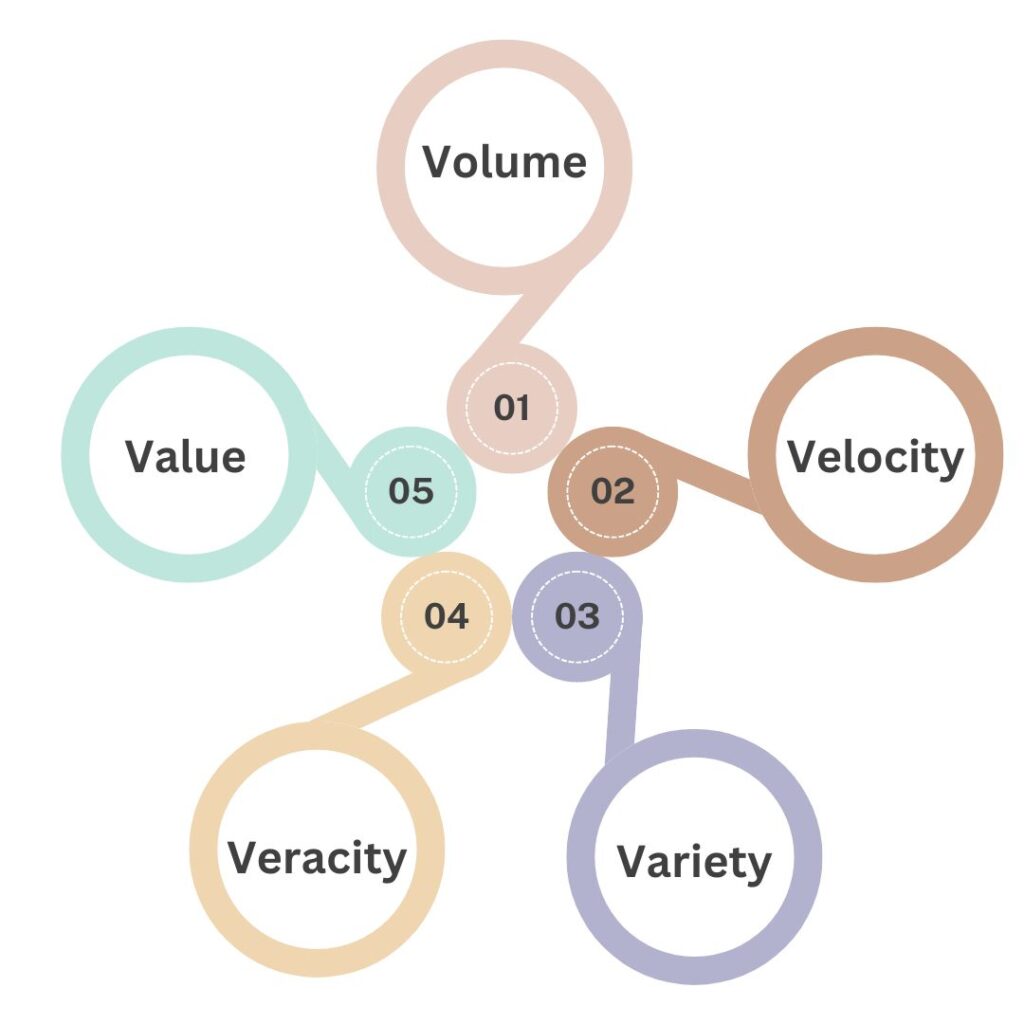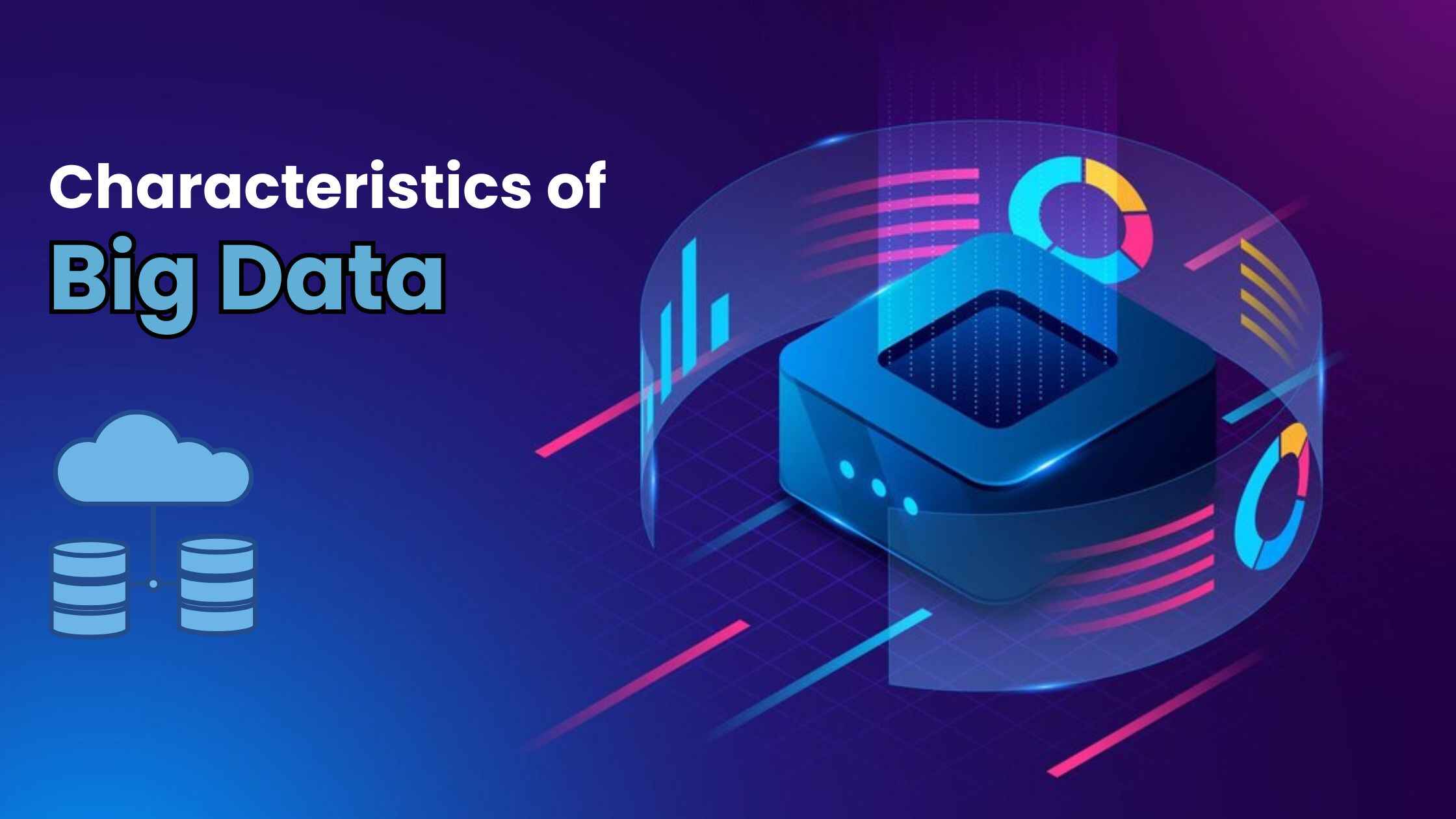Ever wondered what makes big data so… big? Well, it’s not just about size! Big data is like a giant puzzle with lots of pieces that come together to show us important information. To help us understand, experts came up with something called the 5 V’s of Big Data which are characteristics of big data.
Volume, Variety, Velocity, Veracity, and Value are the characteristics of big data also called the 5 V’s of big data. These V’s are like special rules that help us spot and use big data.
In this post, we’re going to break down these 5 V’s in simple terms. Whether you’re new to big data or just curious, stick around to learn what makes big data tick!
Table of Contents
- What is Big Data?
- Characteristics of Big Data (5 V’s)
- Types of Big Data
- How the 5 V’s Work Together
- Conclusion
What is Big Data?

Big data is like a huge collection of information that’s too big for regular computers to handle easily. Imagine trying to count all the grains of sand on a beach – that’s kind of what big data is like!
It comes from all sorts of places: our phones, websites we visit, machines in factories, and even satellites in space. This mountain of information grows super fast, all the time.
Big data isn’t just one type of info either – it can be numbers, words, pictures, or videos. Companies and scientists use special tools to make sense of all this data and learn useful things from it.
Characteristics of Big Data (5 V’s)

Big Data has five main characteristics, often called the 5 V’s. Let’s look at each one:
1. Volume
Volume refers to the enormous amount of data generated every day.
Why is Volume important?
- Provides more comprehensive insights
- Allows for better pattern recognition
- Enables more accurate predictions
Challenges of Volume:
- Requires powerful storage systems
- Needs advanced processing capabilities
- Makes it harder to find relevant information
Real-world example
Facebook users share about 100 terabytes of data daily – that’s like 30 million HD movies!
2. Velocity
Velocity is about the speed at which data is created, collected, and processed.
Key aspects of Velocity:
- Real-time data generation
- Continuous data flow
- Rapid data processing
Why Velocity Matters:
- Enables instant decision-making
- Helps in detecting time-sensitive issues
- Allows businesses to stay competitive
Velocity in action
Stock markets process millions of trades per second, requiring incredibly fast data analysis.
3. Variety
Variety refers to the different types and forms of data.
Types of data in Big Data:
- Structured data
- Organized in databases
- Easy to search and analyze
- Unstructured data
- Not organized in a pre-defined way
- Includes text, images, videos
- Semi-structured data
- Partially organized
- Examples: XML files, JSON data
Challenges of Variety:
- Requires flexible data processing systems
- Needs advanced analytics tools
- Makes data integration more complex
4. Veracity
Veracity is about the trustworthiness and accuracy of data.
Why is Veracity crucial?
- Ensures reliable decision-making
- Prevents costly mistakes
- Maintains trust in data-driven processes
Common Veracity issues:
- Incomplete data
- Biased information
- Inconsistent formatting
- Outdated records
Improving Veracity:
- Data cleaning techniques
- Cross-verification methods
- Regular data audits
5. Value
Understanding Value in Big Data: Value refers to the benefits and insights gained from data analysis.
How to extract Value:
- Use advanced analytics tools
- Apply machine learning algorithms
- Combine data from multiple sources
Areas where Big Data adds Value:
- Customer experience improvement
- Operational efficiency
- Product development
- Risk management
Challenges in realizing Value:
- Identifying relevant data
- Investing in the right tools and skills
- Translating insights into action
Remember: The true power of Big Data comes from combining all these characteristics to gain meaningful insights and drive innovation.
Types of Big Data

Big Data comes in different shapes and sizes. Let’s explore the main types:
1. Structured Data
Structured data is organized in a specific format, making it easy to search and analyze. It’s typically stored in databases or spreadsheets. Think of it like a neatly organized filing cabinet where everything has its place.
Examples of Structured Data:
- Customer information in a company database
- Sales figures in an Excel sheet
- Weather data from sensors
2. Unstructured Data
Unstructured data isn’t organized in a pre-defined way, which makes it harder to search and analyze. Despite this challenge, it actually makes up most of the data in the world. This type of data is like a messy desk with papers, photos, and notes scattered everywhere.
Common Types of Unstructured Data
Unstructured data includes text messages, emails, social media posts, photos, videos, and audio recordings. It’s the kind of information we create and share every day without thinking about how it might be organized or analyzed later.
3. Semi-structured Data
Semi-structured data falls somewhere between structured and unstructured data. It has some organizing features but isn’t as rigidly structured as a database. This type of data often uses tags or markers to separate data elements, making it easier to analyze than unstructured data, but not as straightforward as structured data.
Examples of Semi-structured Data
Examples of Semi-structured Data include XML files, JSON data, and email messages (which have structured headers with an unstructured body).
How the 5 V’s Work Together
The 5 V’s of Big Data don’t work in isolation. They’re like a team, each playing a crucial role in making Big Data useful. Let’s see how they connect:
Volume and Velocity
Imagine a fire hose spraying water. The amount of water is the volume, and how fast it’s coming out is the velocity. In Big Data, we deal with tons of information (volume) coming in really quickly (velocity). This combination means we need powerful tools to catch and process all this data without getting overwhelmed.
Variety: Adds Complexity
Now, picture that fire hose spraying not just water, but also juice, milk, and soda. That’s what variety does to Big Data. It makes handling the volume and velocity even trickier because we’re dealing with different types of information all at once.
Veracity: Quality Control
With so much data of different types coming in fast, some of it might be incorrect or misleading. That’s where veracity comes in. It’s like a filter, helping us figure out what information we can trust and use.
Value: The End Goal
Finally, value ties everything together. After we’ve gathered all this varied data, made sure it’s accurate, and processed it quickly, we need to get something useful out of it. Value is about finding the golden nuggets of insight in the river of information.
A Real-World Example
Let’s say a social media platform is tracking trending topics:
- Volume: Millions of posts every hour
- Velocity: Updates in real-time
- Variety: Text, hashtags, images, and videos
- Veracity: Filtering out spam and fake accounts
- Value: Identifying genuine trending topics that users care about
By working together, these 5 V’s help the platform show users what’s truly popular right now.
Remember: Big Data is powerful because of how these characteristics interact. Understanding this helps businesses and researchers make the most of the information available to them.
Conclusion
In conclusion, understanding the characteristics of big data is key to unlocking its potential. The 5 V’s – Volume, Velocity, Variety, Veracity, and Value – work together to define what makes big data unique and powerful. By grasping these characteristics of big data, we can better handle the flood of information in our digital world. Whether you’re a business owner, researcher, or just curious, knowing these traits helps you make sense of the data-driven world around you.


6 thoughts on “Master the 5 V’s of Big Data: Unlock Its True Potential”